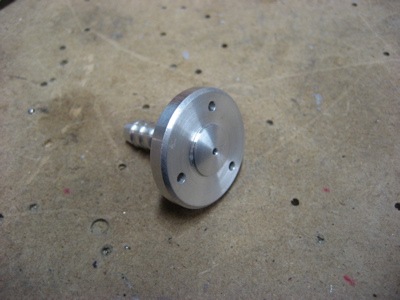I decided to ditch the SafeAir static ports and picked up a set of Cleaveland ports instead. These have a wider protrusion that's more like the rivet they'll be replacing.

From the outside of the fuselage, I enlarged the pilot hole to 1/2" and drilled the three holes through which each port rivets to the fuselage.

To rivet these things in place, I had to crawl way back into the tailcone. To keep from banging up the airplane (and myself) I made these temporary floorboards out of thin particle board scraps I had laying around, and threw down a square of foam rubber too.

Here goes…

Ugh, this is no good. Since the Cleaveland ports are much bigger than the Van's rivet, if you use the plans location for the static ports you'll end up with the port overlapping the F-707 bulkhead flange. Crapola. If you're going to use aftermarket static ports, do yourself a favor and move them about 3/8" forward of the location called out in the plans.

Back out on the workbench, I decided to modify the static ports by cutting off a section, then drilling two more holes symmetrical with the remaining two.

Back into the fuselage again. Mary took a bunch of photos of me doing this. Trust me, it's less fun than it looks.

I backdrilled two more mounting holes per port, then we teamed up to dimple the holes using the pop rivet dimple dies. But first, Mary had to do the old "finger through the F-773 fuselage skin" trick.

It took a few more trips into the bowels of the airplane to get the ports riveted on for good.

There, all done. We put a short filler rivet in the unused fifth hole on each side.

From the outside, the new static ports look not too bad. Mary slipped with the rivet gun and slightly dinged this port, but I think it will be hidden by paint eventually. The swirl marks are from me doing a bit of polishing of a rivet head that was a few thousands proud of the skin.

I think I was in and out of the fuselage a total of six times today. I still need to run the plumbing back to the ports, but I need to pick up some little plastic clamps first.
In retrospect, I probably could have made the simple pop-rivet-as-static-port method called for in the plans work just fine, and it would have been a lot less work and expense. But then I just wouldn't be me.